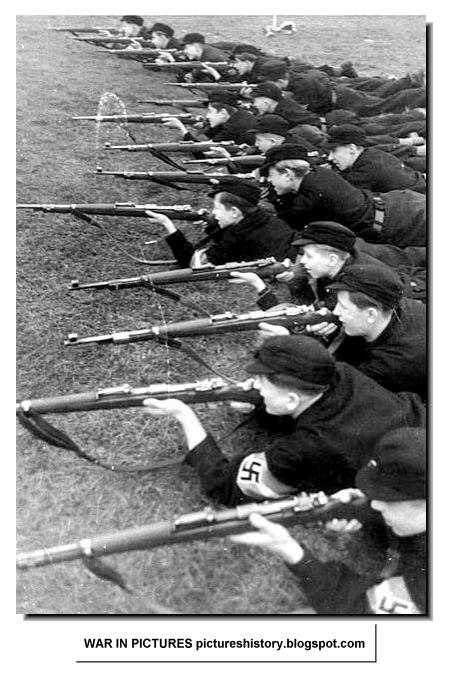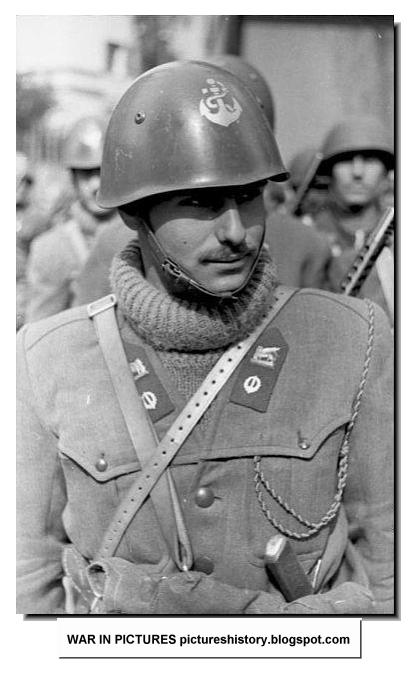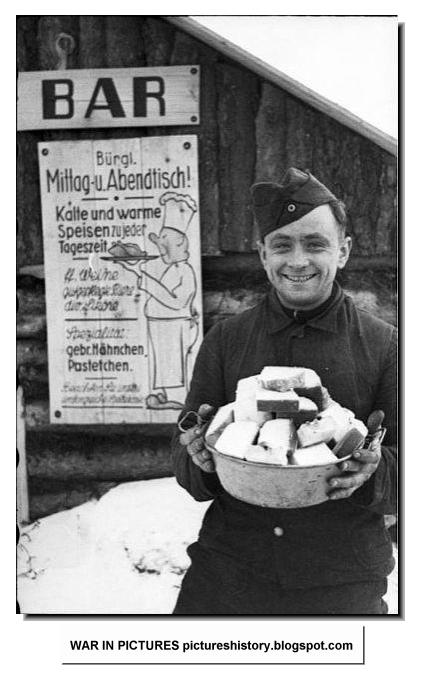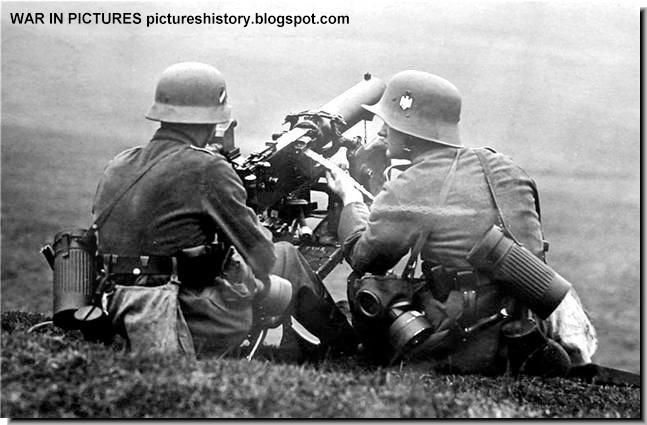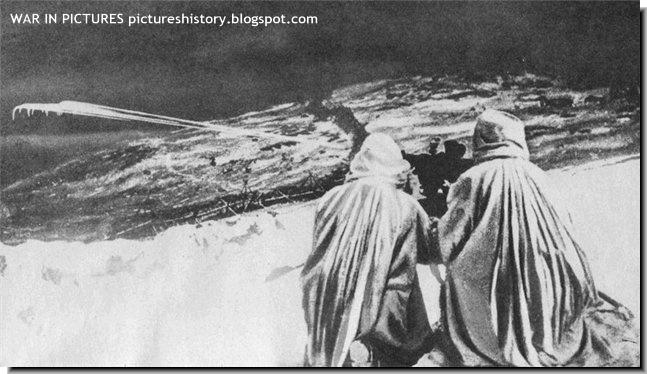German anti-aircraft gun Flak 37
Notes
The 88 mm gun (eighty-eight) was a German anti-aircraft and anti-tank artillery gun from World War II. They were widely used by Germany throughout the war. It was one of the most recognizable German weapons of the war. Developments of the original models led to a wide variety of guns.
The name applies to a series of anti-aircraft guns officially called the 8,8 cm FlaK 18, 36 or 37. FlaK is a German contraction of Flugzeugabwehr-Kanone or Flugabwehr-Kanone (hence the capital K) meaning anti-aircraft gun, the original purpose of the eighty-eight. In informal German use, the guns were universally known as the Acht-acht (8-8), a contraction of Acht-komma-acht Zentimeter (German: "8,8 cm" - comma being used as the decimal separator in German).
With a PzB-39 in Northern France, June 21, 1942. The Panzerbüchse 39 (PzB 39) was a German anti-tank rifle used in World War II. Panzerbüchse means "tank rifle"; the component term "Büchse" is the term for a hunting or sporting rifle (compared to the word "Gewehr" for a rifle in general).
Inspection of personal belongings at the school for Hitler Youth. These schools produced some of the most motivated fighters in the German army
Relaxing. Russia. 1942
Hitler Youth again. Gathering before leaving for summer camp
Training
Shooting practice for the Hitler Youth
France 1943
Italian marine. 1944
Enjoying food in Norway. 1942
Marder 2
WHAT WAS MARDER 2?
The Marder II was a German tank destroyer of World War II based on the Panzer II chassis. The various Marder IIs fought on all fronts of the war, mainly at the Eastern Front.
The Marder IIs were used by the Panzerjäger Abteilungen of the Panzer divisions of both the Wehrmacht and the Waffen SS, as well as several Luftwaffe units.
The Marder's weaknesses were mainly related to survivability. The combination of a high silhouette and open-top fighting compartment made them vulnerable to indirect artillery fire, shrapnel, and grenades. The armor was also quite thin, making them vulnerable to enemy tanks or infantry.
The Marders were not assault vehicles or tank substitutes; the open top meant that operations in urban areas or other close-combat situations were very risky. They were best employed in defensive or overwatch roles. Despite their weaknesses they were much more effective than the towed antitank guns they replaced.
The Marder IIs were used by the Panzerjäger Abteilungen of the Panzer divisions of both the Wehrmacht and the Waffen SS, as well as several Luftwaffe units.
The Marder's weaknesses were mainly related to survivability. The combination of a high silhouette and open-top fighting compartment made them vulnerable to indirect artillery fire, shrapnel, and grenades. The armor was also quite thin, making them vulnerable to enemy tanks or infantry.
The Marders were not assault vehicles or tank substitutes; the open top meant that operations in urban areas or other close-combat situations were very risky. They were best employed in defensive or overwatch roles. Despite their weaknesses they were much more effective than the towed antitank guns they replaced.
Tiger from the Division "Das Reich". . USSR. April 1943.
Peeling potatoes in Poland 1939
Russia. Autumn 1943. The dreaded Rains!
Russia. Autumn 1943
German mine-sweep "Räumer-S": length 15 meters, 4 meters in height weight 130 tons. One of the strangest German vehicles discovered after the war was a huge four wheeled device built by Krupp. This vehicle was the Krupp Räumer S. The only finished Krupp Räumer-S minesweeper was captured in Hillersleben in 1945 by the Americans
The Panzerjäger Tiger (P) Elefant (German "elephant"; model number Sd.Kfz. 184) was a "Schwerer Panzerjäger" (heavy tank destroyer) of the German Wehrmacht in World War II. They were originally built under the name Ferdinand, after their designer, Ferdinand Porsche.
All but two of the 91 available Ferdinands were put to use in the Battle of Kursk, the first combat the Ferdinand saw. Although they destroyed many Russian tanks, they performed quite poorly in other respects. Within the first four days nearly half of the vehicles were out of service, mostly due to technical problems and mine damage to tracks and suspensions. Actual combat losses to direct Soviet action were very low as the Ferdinand's very thick armor protected it from almost all Soviet antitank weaponry. However, at this point in its development the Ferdinand lacked a machine gun or any secondary armament, making it vulnerable to attack by infantry. Most total losses of the Ferdinand occurred during the Soviet counter-offensive after the Kursk offensive, many damaged Ferdinands had to be abandoned as they were too heavy to tow and others were lost to mechanical breakdown during the retreat. The surviving vehicles saw further limited action on the Dniepr front during late 1943.
At this point they were recalled and modified at the works in Austria and received the name Elefant. While the modifications improved the vehicles, some problems could never be fully fixed. In 1944 the Elefants served on the Italian front but were rendered rather ineffective, as their weight of nearly 70 tons did not allow them to use most Italian roads and bridges. Due to a permanent lack of spare parts most of the units were not destroyed in battle, but abandoned and blown up by their own crews. One company of Ferdinands saw action during the Soviets' January 1945 Vistula-Oder Offensive in Poland, and the very last surviving vehicles were in combat at Zossen during the Battle of Berlin.
Strictly in terms of kills per loss, the Ferdinand/Elefant might well have been the most successful tank destroyer employed during the war, reaching an average ratio of approximately 10:1. During the Battle of Kursk, the sPzJagAbt 653 claims to have knocked out 320 enemy tanks, for the price of 13 Ferdinands.This impressive average ratio was due to its extreme firepower-protection ratio, which gave it an enormous advantage when used in head-on combat or a static defensive role. However, poor mobility and mechanical unreliability greatly diminished its offensive capability.
Only two of these vehicles survived the war. One Ferdinand was captured by Soviet forces at Kursk, and is now at the huge Kubinka Tank Museum outside Moscow. An Elefant was captured at Anzio by the Americans, and is now part of the United States Army Ordnance Museum's collection near Aberdeen, Maryland. The example at Aberdeen was restored to display condition in 2007-2008.
SS-Obersturmbannführers Max Wünschen, who was commander of the 12 SS-Panzer Regiment during the fighting in Normady. During his command of the regiment destroyed 250 enemy tanks.
A German soldier with the G43, STG44 and Panzerfaust
A German soldier with a MP44
WHAT WAS MP 44?
The StG 44 (Sturmgewehr 44 or "assault rifle model 1944") was an assault rifle developed in Nazi Germany during World War II and was the first of its kind to see major deployment, considered by many historians to be the first modern assault rifle.It is also known under the designations MP 43 and MP 44 (Maschinenpistole 43, Maschinenpistole 44 respectively), which denotes earlier development versions of the same weapon.
MORE WEHRMACHT IMAGES
MORE WEHRMACHT IMAGES










